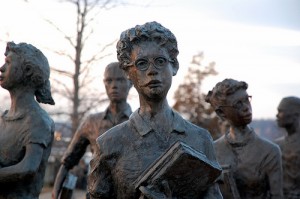
After more than half a century, the U.S.’s efforts to end segregation are winding down. In the years after Brown v. Board of Education, 755 school districts were under desegregation orders. But, according to a new study conducted by Stanford’s Sean Reardon and his colleagues, that number had dropped to 268 by 2009.
So, did Brown v. Board succeed? According to The Atlantic’s Sarah Garland, yes and no.
One of the hopes behind desegregation was that disparities, including decrepit buildings, lower-paid teachers, hand-me-down textbooks, and lagging achievement, would end. And, indeed, after Brown V. Board, court-ordered student reassignment plans were put into place, and the achievement gap between black and white students narrowed at the most rapid rate ever recorded. While many War on Poverty programs were also being implemented, it was clear that desegregation improved outcomes for black students.
But, in many communities, desegregation came with serious sacrifices. Parents (of all races) complained about the hassles that accompanied forced busing, and often children from black families were forced to spend more time commuting. During the 1990s, several Supreme Court decisions made it easier for schools to get out of court supervision, and groups of parents and school districts went to court to fight desegregation orders. As Garland writes:
In the last decade, the speed of re-segregation has accelerated. The Bush administration took a proactive role in pushing for the end of desegregation in more than 200 districts, the Stanford study found. The districts were picked seemingly at random—on average, they still had levels of segregation in their schools that were about the same as the districts that remained under orders. “It wasn’t like in some places desegregation had done a great job and that’s why they were released and in other places there was still work to be done,” Reardon said.
In 2007, the Supreme Court restricted the use of race in school assignments in districts not under court order. Even with new ideas about how to close the achievement gap, since schools began re-segregating during the 1990s, the gap has begun to look entrenched:
The next question Reardon plans to look at is whether re-segregation led to a widening of the achievement gap. Whatever he finds, it’s unlikely that desegregation—at least in its forced-busing form—will ever experience a resurgence. A new generation of reformers has begun looking for ways to create voluntarily integrated schools in order to harness the benefits of racial and other kinds of diversity. “For the people who care about integration, we need a new set of strategies,” [Michael] Petrilli [author of The Diverse Schools Dilemma] said.

Comments 2
Friday Roundup: December 14, 2012 » The Editors' Desk — December 14, 2012
[...] Assessing Brown v. Board of Education on Citings and Sightings [...]
RAEEEFOOISUJMX — August 28, 2018
Fantastic website. A lot of helpful info here. I sending it to several friends ans also sharing in delicious. And naturally, thank you in your sweat!